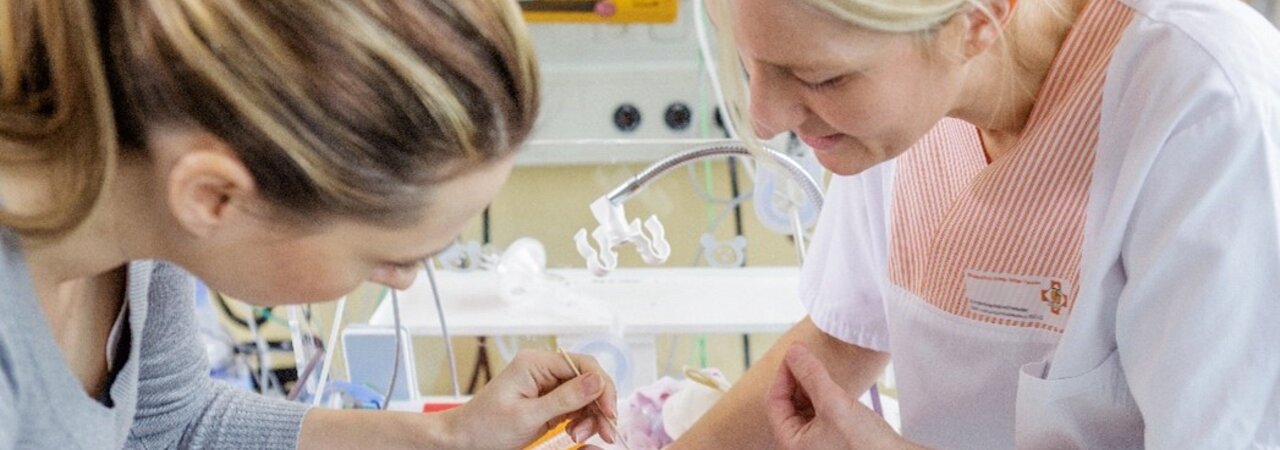You are currently viewing:
Medela - English
You can select an alternative Medela website in one of these countries:
- Products
- Articles
- Medela Family
- Services
- Lactation Professionals
Transition to at-breast feeding
Time to read: 3 min.
The application of drops of OMM to the inside of NICU infants’ cheeks as oral care is considered immune therapy and motivates NICU mothers to initiate pumping early and often and empowers parents’ relationship with their infants

Oral therapy (also known as oropharyngeal care) is the regular application of small amounts (0.1 – 0.2 ml) of own mother's milk (OMM) inside the infant’s cheeks until oral feeds begin.1-6
This can be performed from birth:
Evidence consistently demonstrates oral therapy is safe, inexpensive, feasible and well-tolerated, even in ELBW infants (weighing less than 1000g).1,2,4
Colostrum and early OMM are high in immunologic, anti-infective and anti-inflammatory factors.{2,7} Oral therapy to date is positively associated with
Oral therapy is considered a form of immune therapy.2,4-6
Use of OMM via oral therapy has been shown to:
Collect data on daily administration and frequency of oral therapy
Carry out a monthly data review to measure and monitor first use and frequency of oral therapy:
a) within 24 hours after birth
b) every 2–6 hours until oral feeds commence
Evaluating infant records on a monthly basis within a quality improvement framework, highlights progress, identifies challenges and supports interventions to improve lactation outcomes.
Downloads
1 Snyder R et al. Early provision of oropharyngeal colostrum leads to sustained breast milk feedings in preterm infants. Pediatr Neonatol. 2017; 58(6):534–540.
2 Rodriguez NA et al. A pilot study to determine the safety and feasibility of oropharyngeal administration of own mother's colostrum to extremely low-birth-weight infants. Adv Neonatal Care. 2010; 10(4):206–212.
3 Rodriguez NA, Caplan MS. Oropharyngeal administration of mother's milk to prevent necrotizing enterocolitis in extremely low-birth-weight infants: theoretical perspectives. J Perinat Neonatal Nurs. 2015; 29(1):81–90.
4 Lee J et al. Oropharyngeal colostrum administration in extremely premature infants: an RCT. Pediatrics. 2015; 135(2):e357-66.
5 Gephart SM, Weller M. Colostrum as oral immune therapy to promote neonatal health. Adv Neonatal Care. 2014; 14(1):44–51.
6 Digal KC et al. Oral care with mother's own milk in sick and preterm neonates: A quality improvement initiative. Indian J Pediatr. 2020.
7 Martín-Álvarez E et al. Oropharyngeal Colostrum Positively Modulates the Inflammatory Response in Preterm Neonates. Nutrients. 2020; 12(2).
8 Nasuf AWA et al. Oropharyngeal colostrum in preventing mortality and morbidity in preterm infants. Cochrane Database Syst Rev. 2018; 9:CD011921.
9 Tao J et al. Effects of oropharyngeal administration of colostrum on the incidence of necrotizing enterocolitis, late-onset sepsis, and death in preterm infants: a meta-analysis of RCTs. Eur J Clin Nutr. 2020 [cited 22-Aug-20]; 74(8):1122–1131.
10 Seigel JK et al. Early administration of oropharyngeal colostrum to extremely low birth weight infants. Breastfeed Med. 2013; 8(6):491–495.
Articles that may be of interest